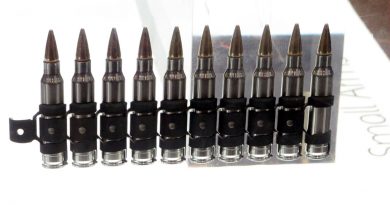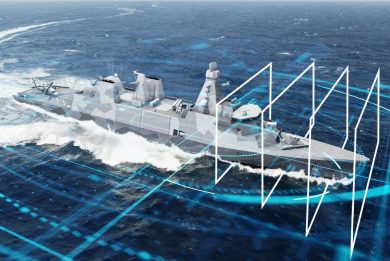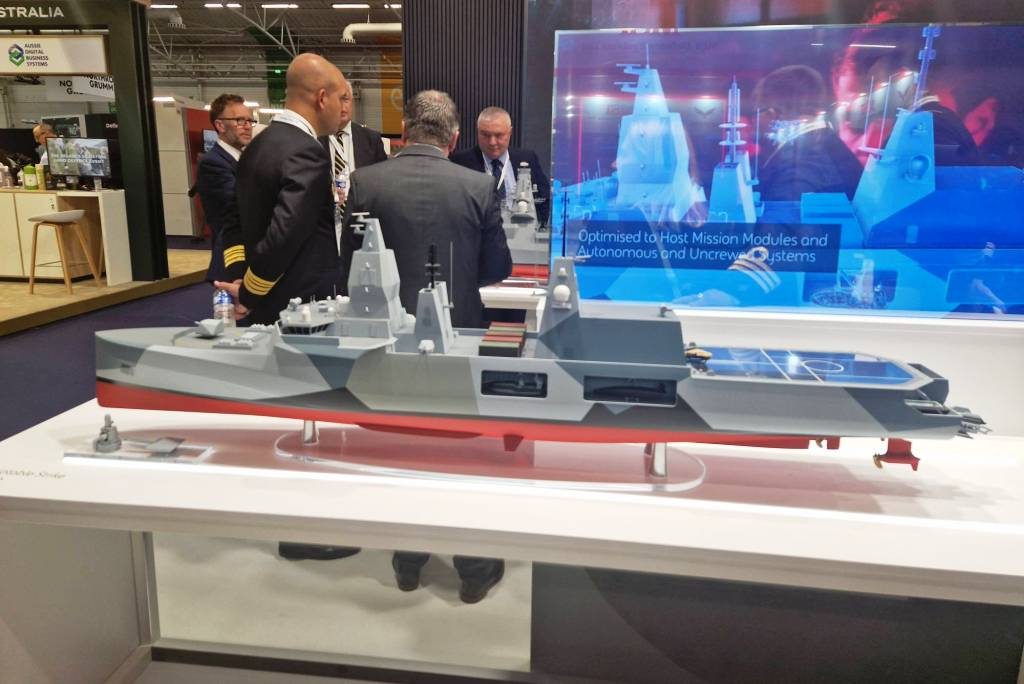
BAE Systems unveils the Adaptable Strike Frigate (ASF)
During Euronaval 2022 BAE Systems publicly displayed the Adaptable Strike Frigate (ASF) warship concept design. Based on the need for adaptable capacity to enable navies to respond “at the speed of relevance whilst operating at range for extended period,” the ASF has been designed “to embrace system of systems modularity to deliver a mission-ready, digitally enable platform”, said BAE Systems representative at the exhibition.
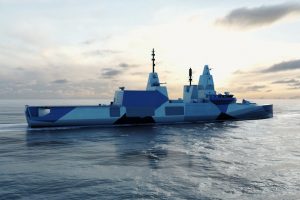
With the ASF, BAE Systems aims at exploring options and industrial solutionsto satisfy what could be the Royal Navy’s Type 32 Frigate programme requirements. Unveiled for the first time in November 2020 by the UK Government as a third type of next generation ships to increase the number of escort platforms for the future RN fleet, the Type 32 has evolved from being primarily a mothership for autonomous vehicles, to a general-purpose frigate. “Equipped with advanced sensors and weapons, the new ship will embrace modularisation to allow these platforms to quickly adopt emerging technologies throughout their life and to switch role depending on the nature of the threat,” the Defence Command Paper (DCP) envisaged in 2021. The latest iteration of the National Shipbuilding Strategy issued on March 2022, looks to these platforms to extend the RN’s forward presence around the world, highlighting that “the Type 32 programme will be the first of a new generation of warships with a focus on hosting and operating autonomous offboard systems that add mass and cost of complexity upon (UK) adversaries”. According to the same document, the Type 32 programme will see up to five ships to be procured, entering service from early 2030s.
Although the UK MoD hasn’t delivered detailed specifications yet, the ASF design derives from the outlines of the mentioned documents as well as from the Maritime Operating Concept (MarOpC) published in September 2022. The latter document describes the maritime domain contribution to the UK’s Integrated Force. “It draws deductions and insights for the Royal Navy and considers the Maritime Domain in its entirety,” the UK MoD introduction explains.
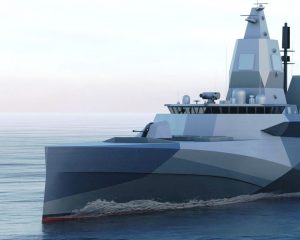
BAE Systems naval architects developed a concept ship that has a matured hull design in order to present a viable and seaworthy platform, a BAE Systems representative highlighted to EDR On-Line during the exhibition. With a length of approximately 130 meters and displacing around 6,000 tonnes, the new concept design is basically divided in a forward end, which is much similar to a conventional frigate, and an aft section that includes the main design innovations. The forward section accommodates on the foredeck a gun and a number of VLS cells of different sizes, displaying enough space for both defensive and offensive missile systems. The exhibited model was equipped with a BAE Systems Bofors 57 mm Mk3 but the platform can accommodate larger guns, four 6-cell VLS for CAMM missiles, and an 8-cell VLS for more powerful air defence and/or anti-ship and land strike missiles.
The same section also includes the bridge area with the forward main mast, in addition to the combat information centre (CIC) and main accommodation spaces. The integrated mast shows a four-fixed faces AESA multifunction radar,while E/O fire control directors and surveillance are visible on the bridge roof. Just behind it, the platform shows a secondary mast for communication systems sided by funnels. The ship armament package also includes two laser defence systems resembling those under testing by the Dragonfire consortium, the joint industry and UK MoD collaboration between MBDA, Leonardo, QinetiQ and Dstl, for the UK’s Laser Directed Energy Programme, and two BAE Systems Bofors 40 mm Mk 4 guns, although other smaller weapon systems are envisaged.
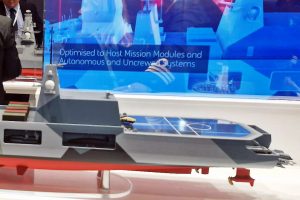
The aft ship section features four main areas or components: the large mission bay with the stern ramp, the hangar structure for a Merlin-type helicopter and UAVs, four boats bays and the amidships area for containerized payloads, in addition to the aft mast with communications and intelligence equipment, and machinery spaces.
Whilst forward deployed to deliver persistent presence, a modular system of systems approach allows the ASF to be reconfigured in a cost-effective manner for a wide range of operations, the BAE Systems representative explained.
The mission bay extends the full length and width under the Chinook capable flight deck. It features a stern ramp capable to accommodate a launch and recovery system capable to operate with high sea state and heavy payloads, including both unmanned surface and underwater vehicles. The mission bay is also accessible from lateral doors and from the same stern ramp by vehicles or containerized modules. A tunnel running under the hangar provides access to the amidship underneath area where an elevator allows the containerized payload to be transferred onto the deck space. Released images show this amidship area accommodating containers and drones, as payload example.
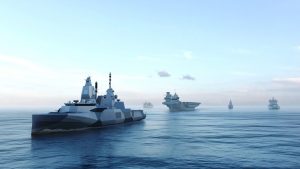
With modularity at its core, BAE Systems has worked with specialist equipment handlers who helped in optimising the movement of containerised capabilities in the challenging maritime domain, to design a flexible deck space that can accommodate over 20 Twenty-foot Equivalent Unit (TEU) containers. BAE Systems has been working with SH Defence to provide modularized capabilities through the Cube system in order to satisfy the rapid re-role requirements at the heart of the ship design.
Instead of vesting capabilities in single platforms, where utility and functions are fixed, the Maritime Operating Concept (MarOpC) highlights that the Royal Navy will distribute capabilities in interchangeable modules such as PODS (Persistent Operational Deployment System). “This increased distribution possible through modular systems enables rapid configuration, increases operational effect and presents the adversaries with more dilemmas,” the same publication highlights.
The four boats bays, two on each side of the ship, are equipped with conventional davits and together with the mission bay can accommodate a range of RHIBs and uncrewed surface and underwater craft. The ship model was showed with a Steller Systems unmanned vehicle. The Royal Marine’s Future Commando Force issued a tender in September 2022 to demonstrate a full-scale prototype of a multi-payload, low-signature, long-endurance uncrewed and subsurface vessel (USSV). This will be able to transit on the surface at speed, quickly transitioning sub-surface for covert delivery of capabilities. According to the BAE Systems representative, the mission bay will allow to accommodate autonomous boats carrying the ARCIMS (Atlas Elektronik Remote Combined Influence Minesweeping System), as well as underwater vehicles such as the Herne XLUUV (Extra Large Unmanned Underwater Vehicle),under development by BAE Systems, also showed in model during the exhibition.
To satisfy the new MarOpC, BAE Systems developed the ASF to be operated as part of a task group or independently,“as being enabled by a digital backbone to unlock the potential of multi-domain operations adopting a cloud based Mission System”. In addition to managing all onboard systems, the ASF digital backbone provides interfaces for modular assets to plug into the system allowing them to provide the capabilities for which they are embarked. The ASF uses automation and a high level of resilient systems integration to enable lean crewing of around 60 elements and maximise adaptable space for specialist augmentees and an embarked military force.
According to the BAE Systems representative, the propulsion system concept so far envisaged for the ASF is based on a combined diesel-electric and diesel-mechanical (CODED) arrangement. The model was showing a centreline shaft with direct diesel drive and two azimuthal pods also known as azipods. In the latter case, the propellers are driven by electric motors installed inside the pods, which can rotate around their own axis providing the required steering capabilities for the platform. These azipods are already applied to logistic support and amphibious ships by different worldwide shipyards, and are in service with different navies. BAE Systems worked for a long time with ABB, but did not considered them for combatant platform designs. This propulsion arrangement, according to BAE Systems, allows high manoeuvrability with sprint capability, eliminating the need for rudders and steering gear, and based on the model shown in Paris, it is more adaptable to the stern design of the ASF with its mission bay and stern ramp.
The new platform will also contribute to reduce the emissions as requested by the UK Government plans, with BAE Systems being working with Rolls-Royce to explore potential solutions that can also increase efficiency and range.

